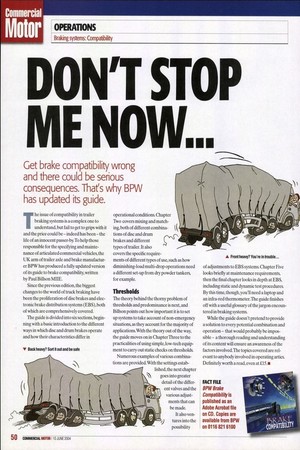DON'T STOP
Page 44

If you've noticed an error in this article please click here to report it so we can fix it.
ME NOW
Get brake compatibility wrong and there could be serious consequences. That's why BPW
has updated its guide.
The issue of compatibility in trailer braking systems is a complex one to understand, but fail to get to grips with it and the price could be —indeed has been — the life of an innocent passer-by.To help those responsible for the specifying and maintenance of articulated commercial vehicles, the UK arm of trailer axle and brake manufacturer BPW has produced a fully updated version of its guide to brake compatibility, written by Paul Billson MIIE.
The issue of compatibility in trailer braking systems is a complex one to understand, but fail to get to grips with it and the price could be —indeed has been — the life of an innocent passer-by.To help those responsible for the specifying and maintenance of articulated commercial vehicles, the UK arm of trailer axle and brake manufacturer BPW has produced a fully updated version of its guide to brake compatibility, written by Paul Billson MIIE.
The issue of compatibility in trailer braking systems is a complex one to understand, but fail to get to grips with it and the price could be —indeed has been — the life of an innocent passer-by.To help those responsible for the specifying and maintenance of articulated commercial vehicles, the UK arm of trailer axle and brake manufacturer BPW has produced a fully updated version of its guide to brake compatibility, written by Paul Billson MIIE.
Since the previous edition, the biggest changes to the world of truck braking have been the proliferation of disc brakes and electronic brake distribution systems (EBS), both of which are comprehensively covered. The guide is divided into six sections, beginfling with a basic introduction to the different ways in which disc and drum brakes operate and how their characteristics differ in
operational conditions. Chapter Two covers mixing and matching, both of different combinations of disc and drum brakes and different types of trailer. It also covers the specific requirements of different types of use, such as how diminishing-load multi-drop operations need a different set-up from dry powder tankers, for example.
operational conditions. Chapter Two covers mixing and matching, both of different combinations of disc and drum brakes and different types of trailer. It also covers the specific requirements of different types of use, such as how diminishing-load multi-drop operations need a different set-up from dry powder tankers, for example.
operational conditions. Chapter Two covers mixing and matching, both of different combinations of disc and drum brakes and different types of trailer. It also covers the specific requirements of different types of use, such as how diminishing-load multi-drop operations need a different set-up from dry powder tankers, for example.
Thresholds
The theory behind the thorny problem of thresholds and predominance is next, and Billson points out how important it is to set up systems to take account of non-emergency situations, as they account for the majority of applications.With the theory out of the way, the guide moves on in Chapter Three to the practicalities of using simple, low-tech equipment to carry out static checks on thresholds.
The theory behind the thorny problem of thresholds and predominance is next, and Billson points out how important it is to set up systems to take account of non-emergency situations, as they account for the majority of applications.With the theory out of the way, the guide moves on in Chapter Three to the practicalities of using simple, low-tech equipment to carry out static checks on thresholds. Numerous examples of various combinations are provided. With the settings estab lished, the next chapter goes into greater detail of the different valves and the various adjust ments that can
be made.
It also ventures into the possibility
of adjustments to EBS systems. Chapter Five looks briefly at maintenance requirements, then the final chapter looks in depth at EBS, including static and dynamic test procedures. By this time, though, you'll need a laptop and an infra-red thermometer. The guide finishes off with a useful glossary of the jargon encountered in braking systems. While the guide doesn't pretend to provide a solution to every potential combination and operation — that would probably be impossible — a thorough reading and understanding of its content will ensure an awareness of the factors involved, The topics covered are relevant to anybody involved in operating artics. Definitely worth a read, even at f15.•
























































































































































































